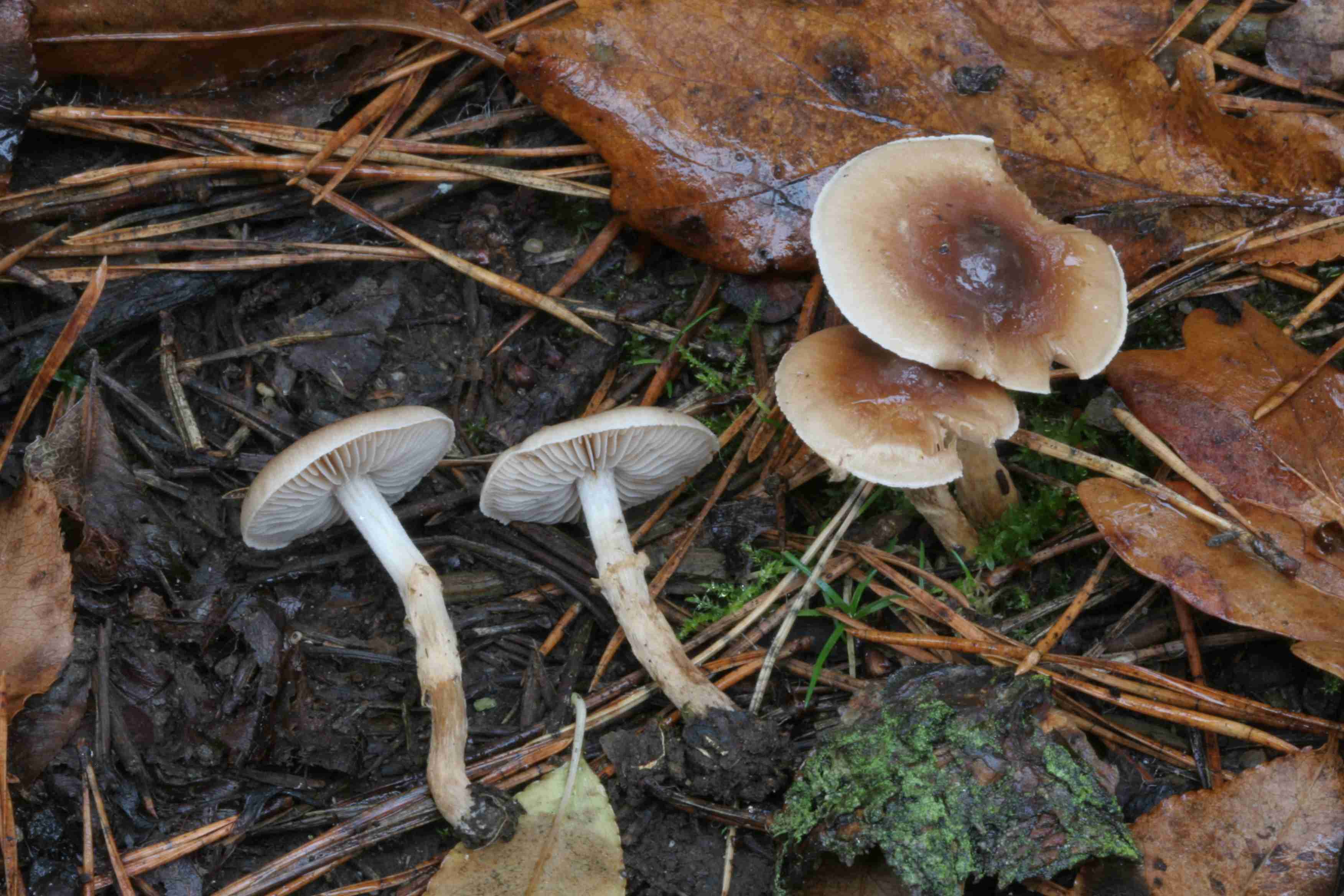The beginnings of the genus
In his Systema Mycologicum Fries (1821) first described Hebeloma as a tribe (“tribus”) of Agaricus within Agaricus series Derminus. He only included one species within this tribe, Agaricus fastibilis Pers. Fifty years later, Hebeloma was elevated to the status of genus by Kummer (1871) and Hebeloma fastibile automatically then became the type for the genus.
Unfortunately, the species that was represented by the name Hebeloma fastibile was a source of great debate. Persoon (1801)'s concept was broad and included the absence of a veil, an unpleasant smell and a fibrillose-floccose stipe. Conversely, while Fries also references veiled and non-veiled species, his diagnosis of A. tribus Hebeloma referenced a veil as an important character.
Having huge controversy around the type of the genus was problematic! To resolve this dilemma, in Beker et al. (2013) we proposed the conservation of the genus Hebeloma with the common European agaric Hebeloma mesophaeum as the type species. This recommendation has been approved and ratified.
Taxonomic placement of genus
The taxonomic placement of Hebeloma has also been challenging. Hebeloma was first placed within the order of Agaricales and the family Agaricaceae by Ainsworth & Bisby in the 1943 edition of the Dictionary of Fungi.
By the 8th edition (Hawksworth et al. 1995), it had moved it to the order Cortinariales and the family Cortinariaceae, but in the 9th edition (Kirk et al. 2001) it reverted back to the Agaricales but now within the family Bolbitiaceae, only to be moved in the 10th edition (Kirk et al. 2008) to the family Strophariaceae.
Possibly influenced by the phylogenetic trees produced by Matheny et al. (2006) as part of the “Assembling the Fungal Tree of Life (AFTOL)” project, Knudsen & Vesterholt (2nd ed, 2012) placed the genus within the family Hymenogastraceae in the order Agaricales. This classification supports current molecular and morphological knowledge and positions Hebeloma alongside Flammula, Galerina, Hymenogaster, Naucoria (Alnicola), Phaeocollybia, Psathyloma and Psilocybe.
| Fungi |
| Dikarya |
| Agaricomycotina |
| Agaricomycetes |
| Agaricomycetidae |
| Agaricales |
| Hymenogastraceae |
The current taxonomic placement of Hebeloma.
Development of infrageneric taxonomic classifications
Infrageneric taxonomy was equally challenging. For a full account see Beker et al. (2016). The development of early work by Konrad & Maublanc (1948) and Kühner & Romagnesi (1953) was built upon by Singer (1962). Bruchet (1970), under the guidance of Kuhner, proposed twelve new species and a key to sections and species, further building on previous work and this was further developed by Boekhout (1982), who recognized new characters as important to the taxonomic placement of species. An important step in the evolution of our understanding of the taxonomy of the genus came from the work of Aanen & Kuyper (1999, 2004) who introduced biological (sexual incompatibility) and molecular (ITS sequencing) techniques to determine Inter-compatibility Groups and whose results supported ideas of Boekhout and laid the foundation for the work of Vesterholt.
The next major revision came from Vesterholt (2005) who published ‘The Genus Hebeloma’ with seven sections: H. sects. Denudata, Hebeloma, Myxocybe, Porphyrospora, Sinapizantia, Theobromina, Velutipes. Vesterholt extended the work of earlier researchers and placed further emphasis on the developing molecular techniques, shifting the focus towards certain morphological characters, particularly: the shape of the cheilocystidia; spore dextrinoidity, ornamentation and degree of loosening of the perispore; the ability of some species to grow roots; odour. In 2006, the sweet-smelling group of Hebeloma was elevated to a separate section, H. sect. Sacchariolentia, by Boyle et al. (2006).
The monograph Beker et al. (2016) introduced five further sections: H. sects. Duracinus, Naviculospora, Pseudoamarescens, Scabrispora, Syrjense. More recently Monedero & Alvarado (2020) added H. sect. Adherentia.
The current taxonomic status of the genus
H. section Adherentia: H. adherens.
H. section 'Australe': H. australe.
H. section Denudata: subsection Clepsydroida: H. album, H. ammophilum, H. asperosporum, H. cavipes, H. cinnamomeum, H. ingratum, H. laetitiae, H. limbatum, H. matritense, H. pseudofragilipes, H. sordidulum, H. vaccinum. subsection Crustuliniformia: H. aanenii, H. alpinum, H. arcticum, H. aurantioumbrinum, H. bellotianum, H. crustuliniforme, H. eburneum, H. geminatum, H. helodes, H. louiseae, H. luteicystidiatum, H. lutense, H. magnicystidiatum, H. minus, H. pallidolabiatum, H. perexiguum, H. pusillum, H. salicicola, H. sporadicum. subsection Echinospora: H. echinosporum, H. populinum, H. rostratum. subsection Hiemalia: H. hiemale.
H. section Duracinus: H. duracinoides.
H. section Hebeloma: subsection Hebeloma: H. alpinicola, H. ambustiterranum, H. angelesiense, H. colvinii, H. excedens, H. harperi, H. marginatulum, H. mesophaeum, H. pascuense, H. psammophilum, H. pubescens, H. subtortum, H. velatum. subsection 'subsect1': H. cistophilum, H. discomorbidum, H. fuscatum, H. grandisporum, H. monticola, H. nigellum, H. paludicola, H. praeolidum, H. sordescens, H. spetsbergense.
H. section 'Islandica': H. islandicum.
H. section 'Mediorufa': H. mediorufum, H. nothofagetorum, H. serratum.
H. section Myxocybe: H. radicosum, H. sagarae.
H. section Naviculospora: H. avellaneum, H. catalaunicum, H. nanum, H. naviculosporum, H. pungens, H. subaustrale, H. subfastibile.
H. section Porphyrospora: H. aminophilum, H. angustilamellatum, H. flavidifolium, H. ifeleletorum, H. indicum, H. lactariolens, H. parvisporum, H. porphyrosporum, H. radicans, H. sarcophyllum, H. victoriense, H. vinosophyllum, H. youngii.
H. section Pseudoamarescens: H. pseudoamarescens.
H. section Sacchariolentia: H. fusisporum, H. ischnostylum, H. nauseosum, H. odoratissimum, H. sacchariolens.
H. section Scabrispora: H. anthracophilum, H. birrus, H. circinans, H. cylindrosporum, H. danicum, H. immutabile, H. laterinum, H. lindae, H. luchuense, H. melleum, H. nitidum, H. olympianum, H. parcivelum, H. pumilum, H. radicosoides, H. viscidissimum.
H. section Sinapizantia: H. albomarginatum, H. bulbiferum, H. sinapizans.
H. section Syrjense: H. syrjense.
H. section Theobromina: H. alboerumpens, H. cohaerens, H. erumpens, H. griseopruinatum, H. kelloggense, H. parvicystidiatum, H. plesiocistum, H. theobrominum, H. vesterholtii.
H. section Velutipes: H. aestivale, H. albidulum, H. caulocystidiosum, H. celatum, H. citrisporum, H. erebium, H. incarnatulum, H. leucosarx, H. mackinawense, H. neurophyllum, H. quercetorum, H. subconcolor, H. velutipes.
